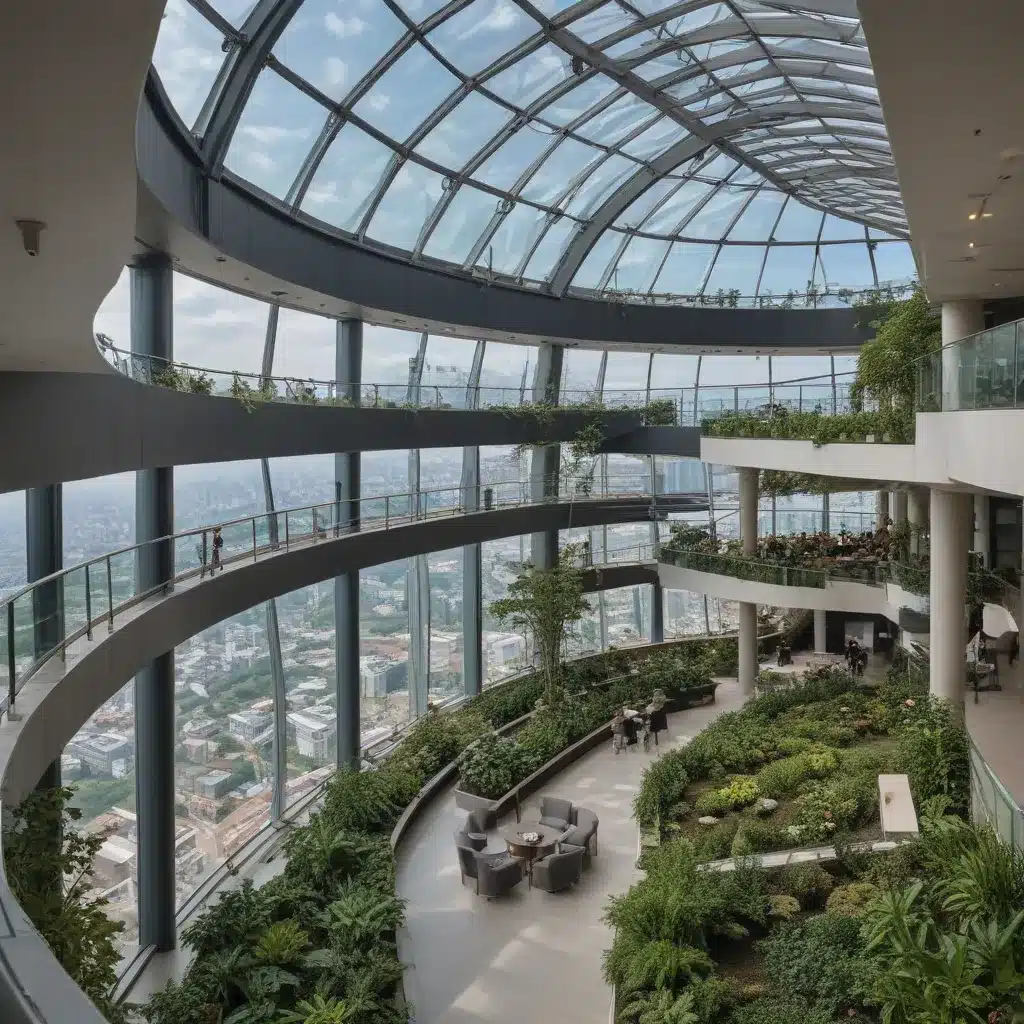
Soaring Above Seoul’s Bustling Streets
As I stroll along the Seoullo 7017 Skygarden, the bustling streets of Seoul stretch out below me. It’s hard to believe that this serene, elevated oasis was once a busy motorway flyover. But thanks to a bold urban transformation, this once-neglected infrastructure has been reborn as a vibrant public space that’s capturing the hearts and imaginations of locals and visitors alike.
MVRDV, the Dutch architecture firm behind this project, has cleverly repurposed the old viaduct, turning it into a “living thing that can adapt to changing conditions.” Their design features a network of pedestrian connections that weave the Skygarden into the surrounding neighborhoods, breathing new life into the area between Seoul Station and the iconic Namdaemun Market.
Embracing the Green
As I meander along the Skygarden’s sinuous pathways, I’m struck by the abundance of greenery. Tall trees, vibrant shrubs, and cascading vines create a lush, verdant oasis that seems to float above the city. It’s a refreshing contrast to the concrete jungle below, and a testament to the architects’ commitment to incorporating nature into the design.
MVRDV faced some unique challenges when it came to the landscaping, as the viaduct’s limited soil depth meant that traditional continuous plantings weren’t feasible. Their solution? Strategically placed circular planters that allow for the inclusion of taller, more visually impactful trees and plants.
As I stop to admire a particularly striking specimen, I can’t help but wonder about the stories these plants could tell. How have they adapted to their lofty new home, and what role will they play in the Skygarden’s ever-evolving ecosystem?
Discovering Hidden Gems
One of the things I love most about the Seoullo 7017 Skygarden is the sense of discovery that permeates the experience. Around every bend, there’s a new surprise waiting to be uncovered – whether it’s a cozy cafe tucked into a circular pavilion, a wading pool perfect for cooling off on a hot day, or a hidden staircase leading to a stunning viewpoint.
The Skygarden is more than just a linear promenade; it’s a dynamic, multifaceted space that invites visitors to explore and engage with their surroundings. I find myself constantly drawn to the various “activators” – the Skygarden’s term for the playful, interactive elements scattered throughout the space.
As I test out a trampoline or pause to admire the reflective art installation, I’m struck by the sheer creativity and attention to detail that has gone into this project. It’s clear that the designers wanted to create an experience that was not only visually stunning, but also endlessly engaging and captivating.
Connecting with the City
One of the most impressive aspects of the Seoullo 7017 Skygarden is the way it seamlessly integrates with the surrounding urban fabric. Unlike the High Line in New York City, which can feel somewhat isolated from its context, the Skygarden is deeply connected to the city it inhabits.
Through a series of strategically placed pedestrian bridges, the Skygarden reaches out to neighboring buildings, inviting visitors to explore the area on foot. It’s a bold move that has paid dividends, with property values in the surrounding area skyrocketing as the Skygarden has become an integral part of the local community.
As I make my way through the Skygarden, I can’t help but marvel at the way it has transformed the urban landscape. What was once a physical barrier has now become a unifying force, bringing people together and fostering a greater sense of connectivity within the city.
Embracing Imperfection
Of course, the Seoullo 7017 Skygarden isn’t without its flaws. The cracked concrete walkways and the occasional spotty plant growth are a testament to the project’s fast-paced timeline and the challenges of transforming aging infrastructure.
But rather than seeing these imperfections as shortcomings, I find them to be a refreshing reminder of the Skygarden’s authenticity. This isn’t a pristine, sanitized park, but rather a living, breathing space that bears the marks of its own evolution.
As MVRDV’s Kyo Suk Lee acknowledges, “Many things were not properly done. We admit that.” But it’s precisely this willingness to embrace imperfection that makes the Seoullo 7017 Skygarden such a remarkable and inspiring project.
A Lesson in Sustainable City-Making
In a world where grand, ostentatious development projects often steal the spotlight, the Seoullo 7017 Skygarden stands as a refreshing example of a more sustainable, people-centered approach to urban transformation.
Rather than draining city resources and prioritizing commercial interests, as the previous administration’s controversial Dongdaemun Design Plaza project had done, Mayor Park Won-soon and his team have focused on enhancing the city’s existing assets and creating public spaces that serve the needs of the local community.
The Skygarden’s emphasis on connectivity, adaptability, and environmental sustainability offers a blueprint for other cities grappling with the challenges of urbanization. It’s a testament to the power of “urban acupuncture” – the idea that targeted, strategic interventions can have a profound impact on the overall health and wellbeing of a city.
As I prepare to bid farewell to the Seoullo 7017 Skygarden, I can’t help but feel a sense of optimism about the future of urban design. This project has shown that by embracing imperfection, prioritizing people over cars, and leveraging the power of existing infrastructure, we can create vibrant, livable cities that are built to last.
So why not plan a visit to the Hotel Stay Inn Seoul and experience the magic of the Seoullo 7017 Skygarden for yourself? Trust me, it’s a tour through Seoul’s past, present, and future that you won’t soon forget.

